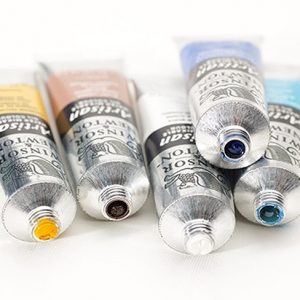(Get free painting tips and plein air painting techniques sent straight to your inbox or on my social media.)
What medium do I use with water soluble oil paints?
You can mix them with water, linseed oil, stand oil, or other solvents. With each, you can get different effects. You can also use fast-drying mediums, impasto and alkyd mediums, as well as use blenders to give heavily pigmented colors a more transparent look.
Traditional linseed oil used to thin water soluble oils will give the painting a nice sheen and add depth to the color. There are specially formulated linseed, safflower, and other oils that have been designed to work with water-soluble oils.
FAQ
-
What Are Water Soluble Oil Paints?

Water soluble oil paints, or water mixable oil paints, are the same as real oil paints with the difference that they can be mixed and cleaned with water. They are also known as water miscible or solvent-free oils. Note that they are not water-based like acrylic and watercolors, but water soluble oil paints contain real oils. The difference from regular oil paint is that water soluble oil paints have been designed to accept water and get around the normal chemical barrier that prevents water and oils mixing. As with other oils, it is very easy to get rich, opaque layers of paint on canvas or board with water soluble oil paints. Creating texture and accenting your brush strokes for effect is also quite easy and similar to traditional oils.
-
Why should I use water soluble oil paints?
There are three main reasons why you may want to use water soluble oil paints:
1. If you like the versatility and vibrant colors you can get with oils but do not like working with solvents for health reasons, then water soluble oil paints are a healthy alternative since you do not need any solvents.
2. If you are working with acrylics but want the beautiful color depth and versatility of traditional oils, then water soluble oil paints will allow you to continue to work with water as you did with acrylics.
3. If you want an easier clean up system than when working with regular oils, then switch to water soluble oil paints.
Many artists enjoy the speed that comes from working with water soluble oil paints. These paints dry considerably faster than traditional oils, though not as fast as acrylics. Depending on how thick you paint, you may get up to 48 hours of workable time with water soluble oil paints before they loose their elasticity. -
What are the differences between water soluble oil paints and traditional oils?
Water soluble oil paints have a faster drying time compared with oils.
You can mix water soluble oil paints with water and so do not need any solvents.
Some pigments are more transparent than they are with their oil-based counterparts. Some artists have noticed this difference with the colors viridian green and cobalt blue.
The one aspect you may enjoy even more with water soluble oil paints is the ease of creating transparent glazes and water-washed underpaintings. This is where the ability to mix the pigment with water is very helpful.
If you use water on its own, it will often create a duller color and make the paint stickier. It doesn’t brush easily or work well when other oils are added.
How do you clean up water soluble oil paints?
Just use water to clean up with water soluble oil paints. This is one of the main advantages. You can use soapy water to clean your brushes. For paint that has partially dried, try to loosen it up by rubbing the bristles with a bit of oil. Your cleaning time is cut in half, you can breathe easily through the process, and you will not be left with colored hands, brushes, and clothes.
Use linseed oil for reviving dried water soluble oil paints on your palette.
Can I mix water soluble oil paints with other paints?
You can mix water soluble oil paints with traditional oils. If you do that though, you will lose some of the ability to mix the paint with water. Some people suggest a small amount of oil (below 25%) is a good range if you want to retain some water solubility. An oil-based solvent such as linseed oil will probably give you a better result.
You can use also use some acrylic paints to mix with your water soluble oil paints. Check with the acrylic paint manufacturer to ensure that it is in fact mixable with water soluble oil paints. It is not possible to use just any acrylic with this type of paint, so be sure to research the brands you intend to use. With acrylics, 25% or below is also a recommended amount for the mix.
About the drying time
- Allow plenty of drying time — a week to a few months depending on thickness and the solvent used — and avoid humid areas.
- To speed up drying time, add a fast-drying medium to your paint.
- If you used water, a shorter drying time is required because water evaporates more quickly than do oil-based solvents.
- Varnish finished paintings as you would any other oil. Before you varnish, make sure the painting is completely dry, not just dry to the touch.
Thank You
Thank you for taking the time to read this article. I hope you find it useful. If you would like to get free painting tips by email, please sign up for my free tips newsletter.
If you are interested in a structured approach for learning how to paint, take a look at my online painting classes.
Happy painting!
Barry John Raybould
Virtual Art Academy








